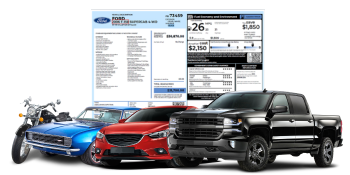Driving is a matter of life and death. Of course, every responsible driver wants to ensure their safety and that of other road users. Fortunately, today’s cars are equipped with features that help protect the driver and other road users.
Whether you’re an advanced or new driver, knowing these car safety features will help you make a smart choice when buying a car. To get an overview of a car’s safety features, check the window sticker label or use an online window sticker lookup by VIN tool to get the window sticker if you can’t find it.
Let’s get down to business in this area!
Quick Facts About Car Safety Features
Some of the innovations making drivers safe today include:
- Airbags: These have been required in all passenger cars since 1999.
- Anti Lock Brakes: This became a requirement in 2000.
- Backup Cameras: These were mandated starting in 2018.
- Electronic Stability Control: Brought into policy in 2012.
- Tire Pressure Monitoring Systems: Also required since 2007.
What are Car Safety Features?
Car safety features are special systems and tools designed to avoid accidents and protect people inside the car when a collision occurs. These may include everything from seatbelts and airbags to advanced technology that helps prevent collisions in the first place.
READ ALSO: Car Ownership Costs: Breakdown and Calculations
Car Safety Features
Next, let’s examine some of the features on almost every new car you buy.
Standard Car Safety Features
Airbags
Airbags are large, cushy pillows that deploy when a car crashes to help absorb the impact and keep the occupants safe.
Required by 1999 for all Passenger Cars, Light Trucks, and Vans: Since then, all cars have to be equipped with at least two airbags for the front seat.
What Is Airbag Deployment?
When a vehicle strikes something solid or even comes to a sudden halt, sensors detect the collision and immediately send a signal to deploy airbags in milliseconds.
Anti Lock Brakes (ABS)
These brakes are designed to prevent wheels from locking up during hard stops, allowing you to maintain control through steering while you’re braking.
Required for 2000 and Later New Passenger Cars: All new cars manufactured after that must be installed with ABS.
How Does ABS Assist Steering?
With ABS, even when you hit the pedal hard onto the brake, the car will still steer smoothly and won’t slide out of control.
Automatic Emergency Braking (AEB)
Automatically engages the brakes if it senses a possible collision. This will be required on all passenger cars, light trucks, and vans by 2029, becoming a standard feature in all vehicles.
Backup Camera
This tiny camera lets drivers see what’s behind them as they back up, thereby allowing them to evade obstructions efficiently.
This is a requirement for all passenger cars, light t, and vans in 2018. It helps in preventing collisions when running in reverse.
Electronic Stability Control (ESC)
It helps the driver maintain the car’s stability during slippery conditions or sharp turns, and it has been a requirement for all passenger cars since 2012.
Safety Belts
Seat belts keep passengers safe. They were required in 1968 for all passenger cars to bring every user to safety. LATCH (Lower Anchors and Tethers for Children) is a special system designed to secure child safety seats.
LATCH was required in 2002 for all passenger cars to provide extra safety for little children, keeping them secure.
TPMS (Tire Pressure Monitoring System)
A system designed to warn the driver that tires need air inflation to prevent blowouts. Since 2007, this has been mandatory on all passenger cars, light trucks, and vans to provide an easy, uncomplicated method of ensuring tire safety.
Traction Control
This prevents wheelspin, particularly on slippery roads. It has been compulsory on all passenger cars since 2011 to add an extra layer of safety for the driver.
Collision Prevention Safety Features
Apart from the standard features, many cars have advanced technologies aimed at preventing collisions.
Blind-Spot Monitoring (BSM)
This warns the driver when a vehicle is in their blind spot and prevents unsafe lane changes.
Brake Assist
This senses when the driver tries to stop quickly and sends additional brake pressure where needed.
Forward Collision Warning (FCW)
This warns the driver when they are approaching the vehicle in front of them too fast.
Intersection Turn Assistance (ITA)
This facilitates safe turns at intersections, especially when oncoming traffic is present.
Lane-Centering Assist (LCA)
This keeps the car centered in its lane without having to constantly steer the car.
Lane-Departure Warning (LDW)
This alerts drivers when they drift out of their lane without using the turn signal.
Lane-Keeping Assist (LKA)
This lightly auto-steers the car to return it to its lane in case it starts drifting.
Lane-Tracing Assist (LTA)
This aids LKA by keeping the vehicle more precisely to the center of its lane.
Pedestrian Detection
This feature detects the presence of pedestrians crossing and automatically applies the brakes in case of need.
Rear Automatic Emergency Braking (RAEB)
This helps prevent collisions, which may happen when reversing, by automatically applying the brakes.
Rear Cross-Traffic Alert (RCTW)
It is a warning device for drivers when there is oncoming side traffic while backing out of parking spots.
Semi-Autonomous Driving
This advanced technology behind self-driving cars allows vehicles to drive themselves while the driver still needs to be alert in many scenarios.
Speed Control Safety Features
These features help regulate the car’s speed and, therefore, can help maintain safe distances.
Adaptive Cruise Control (ACC)
This optimizes the car’s speed to maintain a safe following distance from the vehicle in front.
Automatic Emergency Braking (AEB)
This system automatically deploys the brakes if it feels an impact is imminent.
Traffic Sign Recognition (TSR)
This helps drivers notice and follow traffic signs and speed limits by flashing them on the car’s dashboard.
Vision and Headlight Safety Features
Good visibility is a priority for safe driving, especially at night. Here are some features that make night driving safe and comfortable.
Automatic High Beams
They adjust the car’s headlights according to the traffic around them to provide the best view without dazzling other drivers.
Adaptive Headlights
Their angle of inclination changes concerning the direction of travel according to the car’s steering to throw light upon bends and corners.
Night Vision
This system helps the driver locate pedestrians and animals when there is a low light.
Active Head Restraints
These move forward in a collision to minimize the chance of neck injuries.
Driver-Attention Monitor
This monitors driver actions to determine if the driver is sleepy and gives notifications to stop and rest.
Head-Up Display (HUD)
It throws a beam of vital information, such as speed or navigation, onto the windshield so that drivers do not need to look away from the road.
Parking Assist Systems
These help drivers to park safely by at least guiding them or, for some newer models, automatically steering the car into the spot.
Rain-Sensing Wipers
These are devices that automatically engage the windshield wipers in case of rain.
Rear Occupant Alert
This serves as a reminder for drivers to ensure there is no child or pet in the back seat before they get out.
Safe Exit
This makes passengers aware of oncoming traffic before exiting via doors, thus preventing accidents.
Telematics
This system provides information to the driver regarding the performance and safety of his vehicle.
Conclusion
Every car owner and potential buyer is expected to know about the key car safety features. Most old cars, by nature, will not have advanced safety features, though classic car owners can definitely invest in such changes by adding a little more to their cars. Upgrading with modern features surely adds to the protection and also makes the drive safer. Safety should be considered first, whether when buying a modern or vintage car.
To access the build features of any classic car, simply get the classic build sheet by VIN to verify the specifications, car engine information, transmission, and more.
Frequently Asked Questions
Are all these features standard in new cars?
Not all are standard, but most are controlled by law. Always check which features apply to a particular model; getting the car’s window sticker can provide you with a quick list of the features.
What are the top motor vehicle safety features?
Most automobile companies describe airbags, seat belts, anti-lock brakes, and electronic stability control as crucial features.
Which car has the highest number of advanced safety features?
While many manufacturers strive for the title of the safest car, only some have managed to take precedence with advanced safety technologies, such as Tesla, Volvo, and Subaru.









